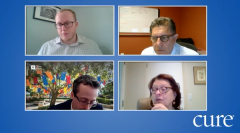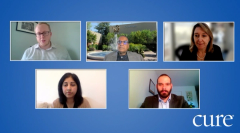
Educated Patient® Lung Cancer Summit Basics of the Disease Panel: June 25, 2022
Watch Dr. Farhad Mazdisnian, Dr. Terence Williams and Dr. Antoinette J. Wozniak answer questions about the basics of the disease during the CURE Educated Patient Lung Cancer Summit.
Episodes in this series

This panel was moderated by Ryan McDonald and featured Dr. Farhad Mazdisnian, Dr. Terence Williams and Dr. Antoinette J. Wozniak.
McDonald: Dr. Mazdisnian, I'd like to start with you first. Somebody had a question about if someone receives a good PET report after some treatment, can this cancer be restaged? And if so, how?
Mazdisnian: Yes, it can. And one of the restaging was, again, by using what we call an endo bronchial ultrasound, where we use a menial ultrasound to biopsy the lymph nodes and get tissue and reanalyze the tissue. So using our robotic techniques to go after lesions that are more in the lung parenchyma and try to biopsy them and look for disease activity. So yes, we usually repeat our procedures, including both by seeing the vision and evaluating the lymph nodes within the mediastinum.
McDonald: Thank you. And then Dr. Williams, we got a question come in about radiation. And one of the questions someone posed was what is the likelihood that radiation can shrink tumors enough in stage 4 so that they are able to have surgery resection?
Williams: That's a good question. You know, I think it sort of depends on where the tumor location is that you're trying to, you know, shrink for potential resection. One of the things about radiation is it takes time to cause tumor shrinkage. We typically deliver radiation, it can take weeks to months before we see some of that shrinkage, whereas some of the systemic therapies can cause tumor shrinkage faster by virtue of how they kill cells. Radiation causes postmitotic death, and the tumors will sit there, they can't divide, which is what's important (they) can't grow, but they'll stay there for a long period of time until the body recognizes them as essentially dead cells and absorbs them. So, you know, we don't typically use radiation a lot in the stage 4 setting to prep patients for surgery. There may be some instances where that is done. You know, it would be very, very much a patient discussion with the physician.
McDonald: Dr. Wozniak, a question coming in. And I think Dr. Williams briefly touched upon this, but you know, what is the decision or the reason for choosing say radiation therapy over lobectomy, assuming that the patient has all the lobes?
Wozniak: Well, just because you have all the lobes doesn't mean that the function is what (we need). So in someone who has poor pulmonary function, and it is preferable to do radiation over surgery, it is apt to be able to tolerate. A patient would be evaluated before surgery, or their tolerance tasks, sometimes cardiac evaluation. Another reason would be if patients or organs are not going to sleep, cardioversion like benification going through surgery. The other thing is the patient views I just had a patient here to do really. So radiation that needs.
McDonald: Dr. Mazdisnian, a question came in from an audience member. If my oncologist submits my cancer tissue for a liquid biopsy, but it was not sufficient enough to succeed is it worth it to have another biopsy so they can have, you know, a different diagnostic?
Mazdisnian: As we like as much tissue as possible, so, yes, and usually with the equipment that we have, and the fact that the risks are very small, I think it's worth getting more tissue, not only in terms of diet, restaging the cancer, but also killing tailoring to therapy in terms of targeted therapy.
McDonald: Thank you, Dr. Williams, I think this is a pretty interesting question. I'd like to hear your thoughts about this, because I'm sure if there's many patients out there wondering this, but is there such a thing as almost getting too much radiation to a specific area? And if so, how is that determined? And then once again, how can I decide or find out if I can get more radiation to that area?
Williams: So there's a lot of factors that go in to, you know, receiving additional courses of radiation. A lot of it has to do with how much time has elapsed between the prior radiation therapy, and where the tumor is located and how much dose the radiation oncologist and treatment team would like to have a goal delivery of the target that tumor, when you have multiple tumors throughout the body, like stage 4 lung cancer or several, let's say, taking the approach of using radiation for consolidation in stage 4 non-small cell lung cancer. If you have several lesions in the lung, or one in the liver, for example, you can probably target them if they haven't, you know, received radiation for and but what's important is measuring the total amount of like, say, treating three or four lesions in lung, measuring the total amount of radiation dose to the lung from all those different treatments.
And so that factors in how much total dose to the to an organ and different organs have different limits. So the liver has different limits than the lung and spinal cord has different limits. And then even the brainstem or the optic structures in the brain. Radiation can be delivered again, to let's say, you treat a tumor with radiation and along and it comes back in the same spot. That's called effective remediation. And that can be done in in certain instances, there's a need to evaluate the amount of time that's elapsed, we prefer to see there's been a longer amount of time that's elapsed, you know, like, ideally, more than a year since the prior radiation, we have to look at what's nearby and how much does the other normal structures nearby have received, for example, here we are already in the lesion of lung, how much the central airways, which are sensitive to radiation and can bleed from repeat causes radiation, how much those organs ever seen before. So a lot of there's a lot that goes into that discussion. And, you know, risks and benefits of radiation versus other things, certainly, as technologies that treatment technologies that you know, needle ablation that can be used in those instances. And certainly surgery can be reconsidered. So I would say it's a real it's really a case by case discussion between the patient and the physician.
McDonald: Thank you. And Dr. Wozniak I'd like to kind of throw this question your way. A question came in from an audience member about how does essentially nutrition and exercise play a factor into the efficacy of, you know, this type of therapy with radiation?
Wozniak: Well, I think, you know, maintaining your lung function is always good through any kind of treatment, whether it's surgery, radiation, and chemotherapy. So I think exercise is a good thing for everybody and also exercise does help your nutrition and that you're more willing to eat I think, you know, good nutrition and exercise are important with any type of you that study that tells you exactly what to eat, or you know, how much exercise to have, but I think it's an important part of maintaining your, your status during your treatment.
McDonald: Now, Dr. Mazdisnian, I'd like to throw this your way and forgive me as I'm not as familiar with this term. So hopefully, you can shed some light on this. So someone wants to know, what are the chances of seeding when using robotic bronchoscope for biopsy compared to needle biopsy?
Mazdisnian: Well, it depends on location of the lesion. But usually there is about 3% or less chance of bleeding. And it's about the same with needle biopsy, I think each time because there is so much blood vessels, especially in the periphery of the line, that when you attempt to biopsy those, you're going to have some bleeding. In my experience and with our divisions experiences, is that following the procedure, patients usually will have some blockage, sputum. And over the next few hours, it usually results. Major bleeding is extremely rare in the needle guided biopsy n and a bronchoscopic. biopsy.
McDonald: Dr. Williams over two question came in. And two things I'll ask the question one, if you don't mind before answering defining this term, because once again, if there's people out there who are not as familiar, but what are the chances of triggering the AP scalpel effect? And are there any, you know, studies out there looking into this?
Williams: Great question. So, the scalpel effect is this effect where let's say you treat one tumor in the body, and there's multiple tumors in the body for example, you treated with written to one tumor with radiation and then you see a response and another tumor. And what it suggests is development of systemic or antitumor response throughout the body that now the immune system is invigorated to go attack another tumor, the different part of the body.
There was some a lot of excitement about abscopal effects, you know, as immunotherapy was coming on board, and we had seen this a number of different common combinations, because the first of all the abscopal effect with radiation alone is very rare. But when you combine with immunotherapy, there was more excitement about you know, can radiation prime the immune system and then in combination with a class of drugs called checkpoint inhibitors, like anti-CTLA4, anti-PD-1/PD-L1, can we see more of this scalpel effect? It hasn't panned out a lot of different disease sites. There is still a lot of interest in lung cancer because there was a recent trial, the Pinborough RT trial. And that was a Dutch trial. And then there was a subsequent Dutch MD interesting combined experience. The data suggest there does appear to be some abscopal responses in patients with non-small cell lung cancer. But it there's a lot there's for exam, there's a recent trial has launched nationally, it's using moderate doses of radiation, we call that a gray times three or 24 Gray. It's not really an ablative dose to test this question now, in a more refined prospective phase 3 randomized fashion. So we don't yet know yet. How often this happens. And you know, to the extent of how useful you know it happens, how useful it is, but it's the questions they'll be investigated in lung cancer.
McDonald: Thank you for that. Dr. Wozniak, we have a question coming in. How does or is proton radiation potentially any safer? If rerating a given area?
Wozniak: I think that's probably a good question for Dr. Williams.
Williams: So um, you know, for proton radiation, there is a lot of interest in using advanced techniques like MRI-guided radiation therapy, or proton radiotherapy for radiation cases, because you can sculpt those around normal organs and do that, you know, or do motion compensated adaptive radiation planning while the patients on the treatment table so there's no clear studies yet suggesting that that approach is the most valuable and you know, obviously, that does require patients to find MRI radiation centers or proton centers and traveling received radiation there. But when you look those symmetrically you know, when you look at sort of like physics-based studies, there is a potential advantage to using those technologies in certain instances of irradiation, especially in your critical organs that have received radiation before like I said, central airways or spine or things like that. But there's, you know, there's the challenge with protons is you can't cut the beam right at the edge of where you want it to end because there's some range and certainty of about 2 centimeters so she's still kind of have to give us on the fudge factor for protons and with MRI-guided radiation, there's also some disadvantages with the photons fell off.
McDonald: Okay, thank you. Dr. Wozniak, I'll bring you back into the fold real quick. So as we've been talking about these topics and the basics of lung cancer, and as we were going through the presentations, a lot of imagery and a lot of various things that some patients might be kind of concerned about, like, “Oh, wow, that's a huge machine, or X, Y, and Z,” all types of things. So what, you know, aside from this, and what we're doing right now, what types of resources are out there to kind of better educate patients on all things in terms of either radiation or staging or biopsy? And can you shed some light on that?
Wozniak: Yeah, I think that one of the biggest resources, your oncologist, or your radiation oncologist, you know, to talk about the importance of staging young machines may be big, but the importance of staging is that it gives us the idea of choosing what the best treatment is very important to stake. And there are a lot of other resources online with the Lung Cancer Research Foundation, LUNGEVITY, they also have, I think they both have call lines, particularly LUNGEVITY, you know, in terms of calling in and asking questions that they have resources, and pamphlets. But I think that, you know, speaking to your doctor, I always have a long conversation with my patients about staging and treatment is probably your best source.
McDonald: Dr. Mazdisnian,a question coming in. Again, guess I'll rephrase this, in a sense, you know, what benefits do robotic bronchoscope have over other modalities and reaching you know, very hard to reach areas?
Mazdisnian: You know, it's kind of interesting, you know, just a little bit historic perspective, when I started doing procedures more than 10 years ago, 15 years ago, we used to use fluoroscopy, to guide a forceps towards the lesion. And if we were considered to be really successful if we were getting our answer in 25% of cases. Now, with improvement in techniques with robotic bronchoscopy, because of the flexibility of the bronchoscope and its ability to go to make, you know, almost 9200 degree turns and the size of the scope, we can go places or we could not go before. So we can reach small lesions up to eight millimeters all the way in the periphery of the line, and actually see where we're going and see what we biopsy. And, and the advantage of us is that I think extends into the future where you actually can deliver therapy, because you're able to reach those small regions. So we've come a long way since I started and then much brighter future had in terms of reaching these regions.
McDonald: Thank you. Dr. Williams, a question for you in terms of obviously, we were talking about radiation during your presentation. You know, obviously people here like the newer techniques or the newer immunotherapies. Can you touch on the role that radiation still plays, and will continue to play in the future?
Williams: Thank you for that question. You know, I think certainly will continue to have a role in stage 1 lung cancer and very excited to see what the results of our randomized trials comparing definitive surgery versus high-dose radiation as SBRT are in that setting. Even stage 2 and stage 3 settings will continue to have roles and then for palliation stage four disease and for potentially cruise control and oligometastatic disease will I think will continue to have roles and it's exciting. It's exciting because again, I mentioned how radiation in the era of immunotherapy which is where a lot of the field is going, how radiation can use potentially to create make what's called a tumor call let's not tumors normally immune immunologically cold or tumor cells, I'm sorry, immune cells are not infiltrating the tumor and attacking the tumor radiation can convert it to a sort of an inflamed or hot environment that allows immune systems come in and, and target those tumor cells both locally and then develop a sort of a vaccine type effect that would then be perpetuated throughout the rest of the body. And then, as we're becoming more and more comfortable with radiation with protons or MRI guided linear accelerated treatment, even some of the newer we'll see what the new PET/CT based treatments will do. I think I think the future is still bright for radiation oncology.
For more news on cancer updates, research and education, don’t forget to















